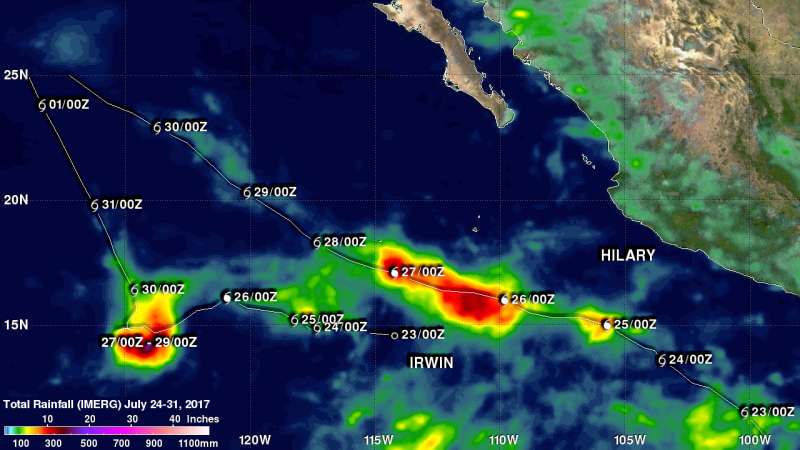NASA looks at Tropical Cyclones Irwin and Hilary rainfall and Fujiwara Effect

NASA used satellite data to tally the rainfall generated by Hurricanes Hilary and Irwin as they interacted in the Eastern Pacific Ocean.
Irwin and Hilary were a little unusual because they traveled so close to each other and interacted. That interaction, known as the Fujiwara Effect radically changed the direction and speed of tropical storm Irwin's movement. The Fujiwara Effect happens when cyclones move close of one another. Their centers will sometimes begin orbiting cyclonically (in the northern hemisphere) about a point between the two systems.
The larger tropical cyclone, Hilary in this case, often dominates the interaction. The smaller tropical cyclone, Tropical Storm Irwin in this case, orbits around the larger tropical cyclone. Sometimes the two tropical cyclones merge into one storm. Irwin did slow down and moved to the northeast. The merging of the two didn't happen this time because Hilary moved over colder waters and lost energy before the two could combine.
Hilary and Irwin's analysis of accumulated rainfall was produced using data from July 24 to 31, 2017 by NASA's Integrated Multi-satellitE Retrievals (IMERG). IMERG uses data from the Global Precipitation Measurement mission or GPM core satellite.
The radical change to Irwin's track by Hilary's circulation is obvious. Hilary's course was expected to become more westerly as it rotated in that direction but that change in course isn't apparent. A maximum of total rainfall to over 500 mm (19.7 inches) occurred where Irwin was forced to slow and become nearly stationary for a while.
Hilary dissipated over cooler waters on July 30, 2017. Irwin also dissipated for the same reason on August 1, 2017 as it tagged along behind Hilary.
Provided by NASA's Goddard Space Flight Center

















